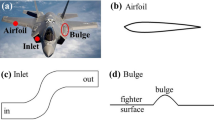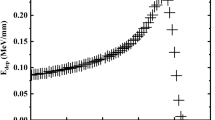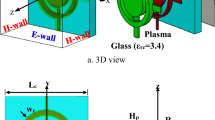Abstract
Open plasma stealth technology excited by radionuclides is known to have several problems: (1) owing to disturbance from airflow, the plasma distribution is unstable. (2) The plasma is highly dependent on the atmosphere; therefore, it is difficult to modulate in target stealth. (3) Concerns regarding radiation harassment prevent the application of this method. To avoid these problems, an enclosed plasma stealth method is introduced. Via simulation on an infinite conducting plate, this method was found to effectively solve the above concerns, which may offer a new approach for the practical application of plasma stealth technology excited by radionuclides, especially for small-satellite stealth because of its lightweight and self-provided plasma.











Similar content being viewed by others
References
H. Liu, Y. Chao, The RCS of the 3-D conductor sphere calculated in THz band and the homogeneous magnetized dense plasma sheath. Optik 208, 164525 (2020). https://doi.org/10.1016/j.ijleo.2020.164525
Z. Cong, Z. He, R. Chen, An efficient volumetric SBR method for electromagnetic scattering from in-homogeneous plasma sheath. IEEE Access 7, 90162 (2019). https://doi.org/10.1109/access.2019.2927264
H.Y. Liu, Y. Chao, S. Liu, Researches on the scattering characteristics in THz band of conductor cylinder coated with parabolic distribution and time-varying plasma media. Optik 207, 163891 (2020). https://doi.org/10.1016/j.ijleo.2019.163891
X. Wei, Y. Chang, M. Lin et al., Study on the influence of thin plasma thickness on electromagnetic wave attenuation. Vacuum 191, 110234 (2021). https://doi.org/10.1016/j.vacuum.2021.110234
S. Nambari, S.R. Gottapu, K.S.R. Rao, Computer-Aided Developments: Electronics and Communication (CRC Press, Boca Raton, 2019), pp. 209–215
Q. Zhang, Z. Tian, W. Tang et al., Study of attenuation characteristics of electromagnetic waves in multilayer plasma slabs. J. Appl. Phys. 125(9), 094902 (2019). https://doi.org/10.1063/1.5037417
X. Han, H. Xu, Y. Chang et al., Investigation on the parameters distribution and electromagnetic scattering of radome inductively coupled plasma. IEEE Trans. Antennas Propag. 69(12), 8711–8721 (2021). https://doi.org/10.1109/TAP.2021.3088265
N. Kumar, S.R. Vadera, Aerospace Materials and Material Technologies: Aerospace Materials (Springer, Singapore, 2017), pp. 519–537
W. Liu, J. Zhu, C. Cui et al., The influence of plasma induced by \(\alpha\)-particles on the radar echoes. IEEE Trans. Plasma Sci. 43(1), 405–413 (2014). https://doi.org/10.1109/TPS.2014.2370060
W. Liu, J. Zhu, C. Cui et al., Influence of plasma induced by radionuclide layer on the radar cross section of spherical objects. Nucl. Sci. Tech. 26, 040502 (2015). https://doi.org/10.13538/j.1001-8042/nst.26.040502
V.L. Ginzburg, W.L. Sadowski, D.M. Gallik et al., Propagation of electromagnetic waves in plasma. Phys. Today 15(10), 70 (1962). https://doi.org/10.1063/1.3057811
J.R. Rumble, Handbook of Chemistry and Physics (CRC Press, Boca Raton, 2017), pp. 14–19
M.A. Lieberman, A.J. Lichtenberg, Principles of Plasma Discharges and Materials Processing (Wiley, Hoboken, 2005), pp. 133–160
A. Von Engel, Electric Plasmas-Their Nature and Uses (Taylor & Francis Ltd, London, 1983), pp. 55–84
C. Borgnakke, R.E. Sonntag, Fundamentals of Thermodynamics (Wiley, Hoboken, 2020), p. A-86
H. Kudo, Radiation Applications (Springer, Singapore, 2018), pp. 51–62
L. Cerrito, Radiation and Detectors: Introduction to the Physics of Radiation and Detection Devices (Springer, Switzerland, 2017), pp. 97–135
H. Nikjoo, S. Uehara, D. Emfietzoglou, Interaction of Radiation with Matter (CRC Press, London, 2012), pp. 119–130. https://doi.org/10.1201/b12109
C.W. Allen, A.N. Cox, in Allen’s astrophysical quantities (Springer, Berlin, 2000), pp. 37–47
H.A. Macleod, Thin Film Optical Filters (CRC Press, Boca Raton, 2010), pp. 38–47
H. Dodiuk, S.H. Goodman, Handbook of Thermoset Plastics (Elsevier Inc., New York, 2013), pp. 75–91. https://doi.org/10.1016/C2011-0-09694-1
H.V. Markel, Introduction to the Maxwell Garnett approximation: tutorial. J. Opt. Soc. Am. A 33, 1244 (2016). https://doi.org/10.1364/JOSAA.33.001244
X. Sun, Y. Li, Y. Huang et al., Achieving super broadband electromagnetic absorption by optimizing impedance match of rGO sponge metamaterials. Adv. Funct. Mater. 32(5), 2107508 (2022). https://doi.org/10.1002/adfm.202107508
Author information
Authors and Affiliations
Contributions
All authors contributed to the study conception and design. Material preparation, data collection and analysis were performed by Jin-Jian Yuan, Gui-Ping Meng, Min Gu and Run-Sheng Huang. The first draft of the manuscript was written by Jin-Jian Yuan, and all authors commented on previous versions of the manuscript. All authors read and approved the final manuscript.
Corresponding author
Rights and permissions
About this article
Cite this article
Yuan, JJ., Meng, GP., Gu, M. et al. A new radar stealth design excited by \(^{210}\)Po and \(^{242}\)Cm. NUCL SCI TECH 33, 71 (2022). https://doi.org/10.1007/s41365-022-01061-7
Received:
Revised:
Accepted:
Published:
DOI: https://doi.org/10.1007/s41365-022-01061-7




